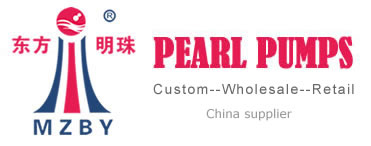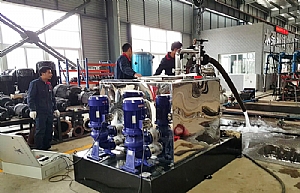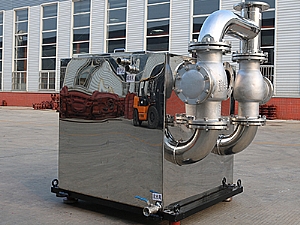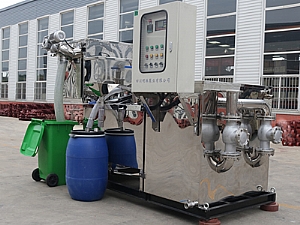How does a sewage lift pump work?
How a Sewage Lift Pump Works
In the modern urban landscape, sewage systems play a crucial role in maintaining hygiene and sanitation. A key component of these systems is the sewage lift pump, a device designed to transport wastewater from lower to higher levels, overcoming the limitations of gravity. This article will delve into the workings of a sewage lift pump, its components, and its significance in modern urban infrastructure.
The Basics of Sewage Lift Pump Operation
A sewage lift pump is a specialized pumping system that is installed in underground chambers or sumps to collect and transport wastewater from buildings or areas where gravity-fed drainage is not feasible. These pumps are typically activated by a float switch that detects the rising water level in the sump. As the water level reaches a pre-set point, the switch activates the pump, which then begins to operate, drawing the wastewater into the pump chamber and discharging it through a discharge line to a higher-level sewer main or treatment facility.
Components of a Sewage Lift Pump System
A sewage lift pump system consists of several components that work together to ensure efficient and reliable operation. The key components are:
Pump Chamber: This is the housing where the pump motor and impeller are located. It is designed to contain the wastewater while the pump is in operation.
Impeller: Attached to the pump motor, the impeller rotates rapidly, creating a suction effect that draws the wastewater into the pump chamber. The impeller also propels the wastewater out of the pump through the discharge line.
Float Switch: A mechanical or electronic device that detects the water level in the sump. When the water reaches a certain level, the float switch activates the pump motor.
Motor: The power source that drives the impeller. Motors can be electric, pneumatic, or hydraulic, depending on the specific application.
Discharge Line: A pipe that connects the pump chamber to the sewer main or treatment facility. The wastewater is propelled through this line by the impeller.
Check Valve: Installed in the discharge line, a check valve prevents backflow of water into the pump chamber when the pump is not operating.
Alarm System: An optional component that can be integrated into the system to provide alerts if there are any malfunctions or issues with the pump.
Working Principles
The working principle of a sewage lift pump is based on the simple concept of suction and pressure. As the impeller rotates, it creates a low-pressure area in the pump chamber, drawing the wastewater into the chamber. The impeller then propels the water through the discharge line, creating a higher-pressure area that pushes the wastewater to its destination.
The float switch plays a crucial role in automating the operation of the pump. As the water level in the sump rises, the float rises with it. When the float reaches a pre-set level, it activates the pump motor, initiating the pumping cycle. Once the water level in the sump drops below a certain point, the float switch deactivates the motor, allowing the pump to rest until the next cycle.
Significance in Urban Infrastructure
Sewage lift pumps are essential in urban infrastructure, especially in areas where gravity-fed drainage is not possible. They allow wastewater from basements, bathrooms, kitchens, and other areas of buildings to be collected and transported to the main sewer line or treatment facility. Without these pumps, wastewater would accumulate in basements and other low-lying areas, leading to unsanitary conditions and potential health hazards.
In addition to their basic function of transporting wastewater, sewage lift pumps also contribute to the overall efficiency and reliability of the sewage system. By automating the pumping process and preventing backups and overflows, they help to maintain the flow of wastewater through the system, reducing the risk of system failures and minimizing the impact of flooding or other emergencies.
PEARL Pump: A Trusted Supplier of Sewage Lift Equipment in China
PEARL Pump, as a leading supplier of sewage lift equipment in China, offers a comprehensive range of pumps and systems that are designed to meet the specific needs of customers. With a focus on quality and reliability, PEARL Pump provides high-performance pumps that are built to last. The company also offers customization options, allowing customers to specify the exact pump configuration and features that they require.
By choosing PEARL Pump as your supplier of sewage lift equipment, you can ensure that you receive a reliable and efficient system that will meet your specific needs and contribute to the overall performance of your sewage system.
In conclusion, the sewage lift pump is a vital component of modern urban infrastructure, enabling the efficient and reliable transport of wastewater from buildings and low-lying areas to the main sewer line or treatment facility. Its operation relies on simple principles of suction and pressure, and its importance in maintaining hygiene and sanitation cannot be overstated.
- What is a vacuum pump used for?[ 2024-05-01 ]
- Where is diaphragm pump best suited?[ 2024-04-29 ]
- What is the major disadvantage of submersible pump?[ 2024-04-12 ]
- What are the disadvantages of self priming pumps?[ 2024-04-11 ]
- What is a sewage lift system?[ 2024-05-09 ]
- How many pumps does a pump station have?[ 2024-06-13 ]
- Is a filter pump better than a sand pump?[ 2024-05-30 ]
- What is a Mud Pump Used For?[ 2024-05-21 ]
- What is an industrial pump?[ 2024-04-09 ]
- Who is the best pump manufacturer in China?[ 2024-05-07 ]







